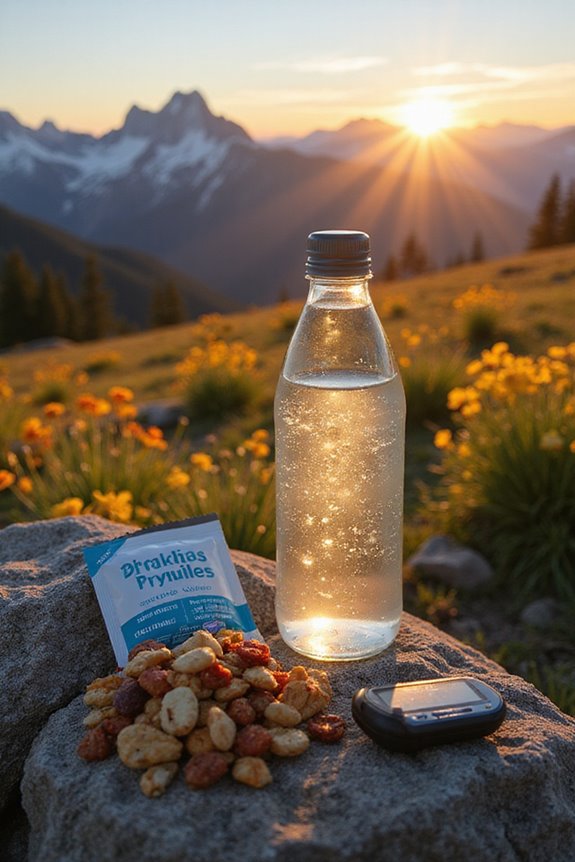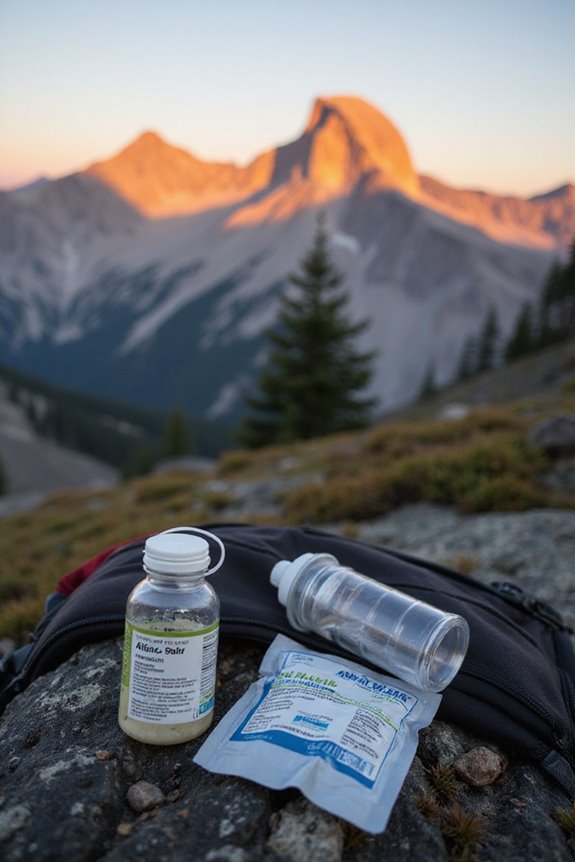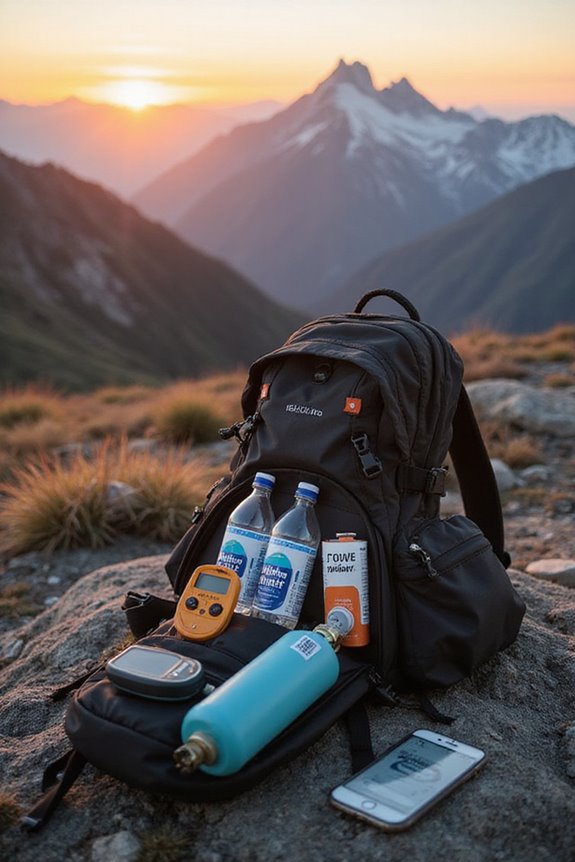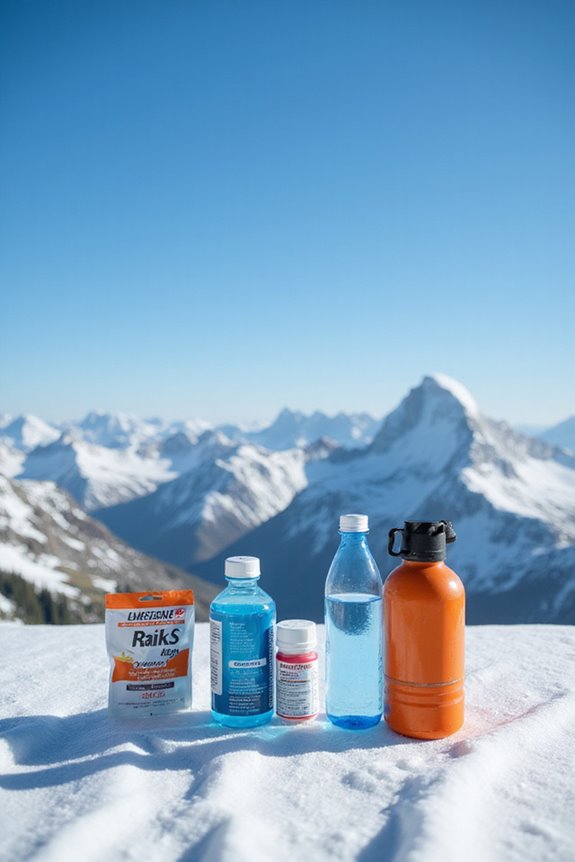To avoid altitude sickness, it’s essential to ascend gradually, ideally moving up just 300 to 500 meters a day. Staying hydrated is key; aim for 4 to 6 liters of water each day. Snack smartly—carbs and salty treats are your friends. Listen to your body; if you feel dizzy or get a headache, slow down and acclimatize. And hey, don’t forget to plan rest days into your itinerary! Exploring the details can reveal even more tips for a successful adventure.
Key Takeaways
- Gradually ascend, raising sleeping altitude by 300 to 500 meters daily after 2,500 meters, allowing ample time for acclimatization.
- Stay hydrated by drinking 4 to 6 liters of water daily, even if you don’t feel thirsty.
- Consume carbohydrate-rich snacks and salty foods to maintain energy levels and replace lost sodium.
- Consider pre-acclimatization by spending time at higher altitudes before attempting to reach your final destination.
- Monitor for early symptoms of altitude sickness, such as headaches or nausea, and be prepared to descend if they arise.
Gradual Ascent and Acclimatization Strategies
When it comes to tackling altitude sickness, a little patience can go a long way—think of it as a slow dance rather than a sprint. Embracing a staged ascent is key; it’s like letting your body warm up before a big performance. Experts recommend raising sleeping altitude by only 300 to 500 meters each day after reaching 2,500 meters. It’s essential to spend 6 to 7 days at moderate altitudes, allowing your body to adapt through altitude acclimatization. If you start feeling symptoms, don’t hesitate to hit pause and descend a bit. Remember, this isn’t a race; it’s about giving your body the time it needs to adjust, ensuring you can enjoy the breathtaking views without the headache of altitude sickness.
Importance of Hydration and Nutrition

Hydration and nutrition play a pivotal role in keeping adventurers safe and sound at high altitudes. To combat altitude sickness, adventurers should embrace effective hydration strategies, drinking about 4 to 6 liters a day, even if thirst signals are muted. Regular sips, like 8 ounces every 30 minutes, can keep dehydration at bay. Adding electrolyte drinks helps balance those essential minerals. Nutrition tips include munching on carbohydrate-rich snacks and salty treats to replace lost sodium from increased urination. Small, frequent meals are usually easier on the stomach, too. So, remember, staying hydrated and fueled not only enhances energy but also supports your body’s fight against altitude-related woes. After all, who wants a headache when there’s a mountain to conquer?
Lifestyle Adjustments for High Altitude

As adventurers set their sights on high-altitude destinations, they quickly realize that preparation goes beyond just packing the right gear; it involves making thoughtful lifestyle adjustments to guarantee a smooth journey. Key lifestyle changes include pre-acclimatization, which means spending time at elevation before pushing higher. It’s also essential to ascend gradually—traveling no more than 1,000 feet per day helps the body adapt. Incorporating rest days is important for altitude fitness, especially after gaining significant elevation. Avoiding strenuous activities in those initial days can make a world of difference, as can sleeping at lower elevations. Finally, paying attention to how one’s body feels serves as a critical guide, ensuring a safe and enjoyable high-altitude experience without the unwelcome surprise of altitude sickness.
Medications for Prevention and Management

Medications can be a game changer for those venturing into the heights where the air gets thin and altitude sickness lurks around every corner. Options like acetazolamide (Diamox) are incredibly popular, with dosage guidelines suggesting 125 mg twice daily, ideally starting a day before your ascent. For more immediate relief, dexamethasone can tackle acute mountain sickness with a dosage of 4 mg every six hours, but it’s best for short-term use. Ibuprofen, at 600 mg every eight hours, is a handy over-the-counter choice to ease headaches. And for those at risk of high altitude pulmonary edema, nifedipine is key, typically dosed at 30 mg twice daily. Choosing the right medication can make your high-altitude adventure enjoyable rather than a dizzying ordeal!
Recognizing Early Symptoms of Altitude Sickness

Altitude sickness can sneak up on even the most prepared adventurers, turning a dream trek into a dizzying nightmare. Recognizing early signs is vital for a safe journey. The first hint often comes as a throbbing headache that might keep you up at night. Nausea and a sudden loss of appetite can quickly follow, leaving you feeling uneasy. Fatigue, dizziness, and that pesky “pins and needles” sensation may also make their appearance. Don’t ignore sleep disturbances either; tossing and turning is a red flag. These symptoms typically develop within 6 to 12 hours of ascent. If you notice these signs, it’s important to listen to your body and consider descending or acclimatizing to avoid worsening conditions.
Environmental and Behavioral Strategies
When preparing for high-altitude adventures, it’s essential to contemplate not only the breathtaking views but also the environment and behaviors that can make or break the experience. Managing environmental exposure is key; dressing warmly can stave off cold stress and protect against harsh UV rays. Staying hydrated is vital too—nothing ruins a trek like dehydration! Behavioral adaptations, like ascending slowly and taking rest days, can greatly enhance acclimatization. Eating small, frequent meals keeps energy levels steady, while avoiding alcohol and caffeine helps prevent dehydration. Remember to sleep well and avoid strenuous activities before bed. By embracing these strategies, adventurers can enjoy the thrill of high altitudes without falling victim to altitude sickness, making every moment unforgettable.
Planning Your Itinerary for Acclimatization
Planning an itinerary for high-altitude adventures can make all the difference between a memorable trip and a struggle against altitude sickness. To guarantee safety, travelers should prioritize itinerary flexibility, allowing for rest days and the option to halt ascent if symptoms arise. Incorporating altitude checkpoints is vital; spending 2-3 nights at intermediate elevations helps the body adjust. Ascending no more than 500 meters per night above 3,000 meters keeps the risks at bay. It’s wise to plan stops at moderate altitudes, where travelers can monitor for symptoms like headaches or fatigue. With a well-structured itinerary, adventure seekers can embrace the beauty of high altitudes without the looming threat of altitude sickness ruining their experience.
Understanding Individual Susceptibility
As travelers gear up for high-altitude adventures, understanding individual susceptibility to altitude sickness becomes paramount. Not everyone is equally affected by altitude, and factors like age influence and genetic factors play significant roles. For instance, children face the same risks as adults, while those over 50 have a slightly lower chance of developing altitude sickness. Genetic makeup can also dictate how well someone acclimatizes; populations like Tibetans and Andeans have varying rates of chronic mountain sickness due to their unique genetic backgrounds. So, while fitness and previous experience might seem like shields against altitude sickness, they don’t guarantee immunity. Ultimately, knowing one’s individual susceptibility can make all the difference between enjoying the breathtaking views or battling a headache at 10,000 feet.
Pre-acclimatization Techniques
Altitude sickness can feel like a sneaky villain, ready to ruin a perfectly good adventure in the mountains. To outsmart this foe, pre-acclimatization techniques come to the rescue. Imagine spending 6-7 days at a moderate altitude, like 2,500 meters, gradually allowing your body to adjust. This staged ascent can protect against acute mountain sickness, making your climb smoother. Additionally, incorporating hypoxic exposure at home, such as sleeping in altitude tents, can trigger essential physiological changes. For those keen to boost their game, altitude training combined with exercise—think stationary cycling in low oxygen—can enhance your adaptations. Embracing these techniques not only prepares the body but also transforms the intimidating climb into a triumphant journey.
Emergency Response to Severe Symptoms
Recognizing severe altitude sickness symptoms can feel like a race against time, and knowing how to respond can make all the difference. When confusion, breathlessness, or a bluish tint appears, it’s a clear signal for emergency response. First, descend urgently—aim for at least 300 to 1,000 meters. If that’s not possible, start supplemental oxygen right away. It’s essential to have a buddy to help monitor the situation, as self-assessment might falter. Keep the individual calm and warm; exertion is a no-go. Remember, never let someone with severe symptoms travel alone; their condition could worsen. Quick action is critical to avoid a tragic outcome. In these moments, every second counts, so stay alert and ready to act!
Frequently Asked Questions
How Can Altitude Sickness Affect Athletic Performance?
Altitude sickness diminishes athletic performance by reducing oxygen availability, particularly during high exercise intensity. Athletes experience decreased endurance and strength, with notable effects on aerobic activities as elevations increase, resulting in significant performance decrements for longer durations.
What Are the Long-Term Effects of Repeated Altitude Exposure?
Repeated altitude exposure can lead to long-term adaptations, but it may also result in chronic mountain sickness, characterized by impaired cognitive function, reduced exercise capacity, and structural brain changes, particularly affecting vulnerable populations.
Can Altitude Sickness Be Hereditary?
Altitude afflictions appear hereditary, influenced by genetic predisposition and family history. Genetic variations among populations reveal distinct adaptations, effectively reducing susceptibility to altitude sickness, highlighting the intricate interplay between heredity and environmental factors in high-altitude resilience.
Are There Specific Populations More Prone to Altitude Sickness?
Certain populations, such as elderly individuals, pregnant women, and those with pre-existing conditions, show increased susceptibility to altitude sickness. Implementing acclimatization strategies may help mitigate risks for these vulnerable groups during high-altitude ascents.
What Role Does Fitness Level Play in Altitude Sickness Risk?
Research shows that 60% of individuals experience altitude sickness symptoms regardless of fitness adaptation. While exercise impact enhances performance, it does not mitigate risk; rapid ascent and acclimatization remain vital factors influencing altitude sickness susceptibility.





